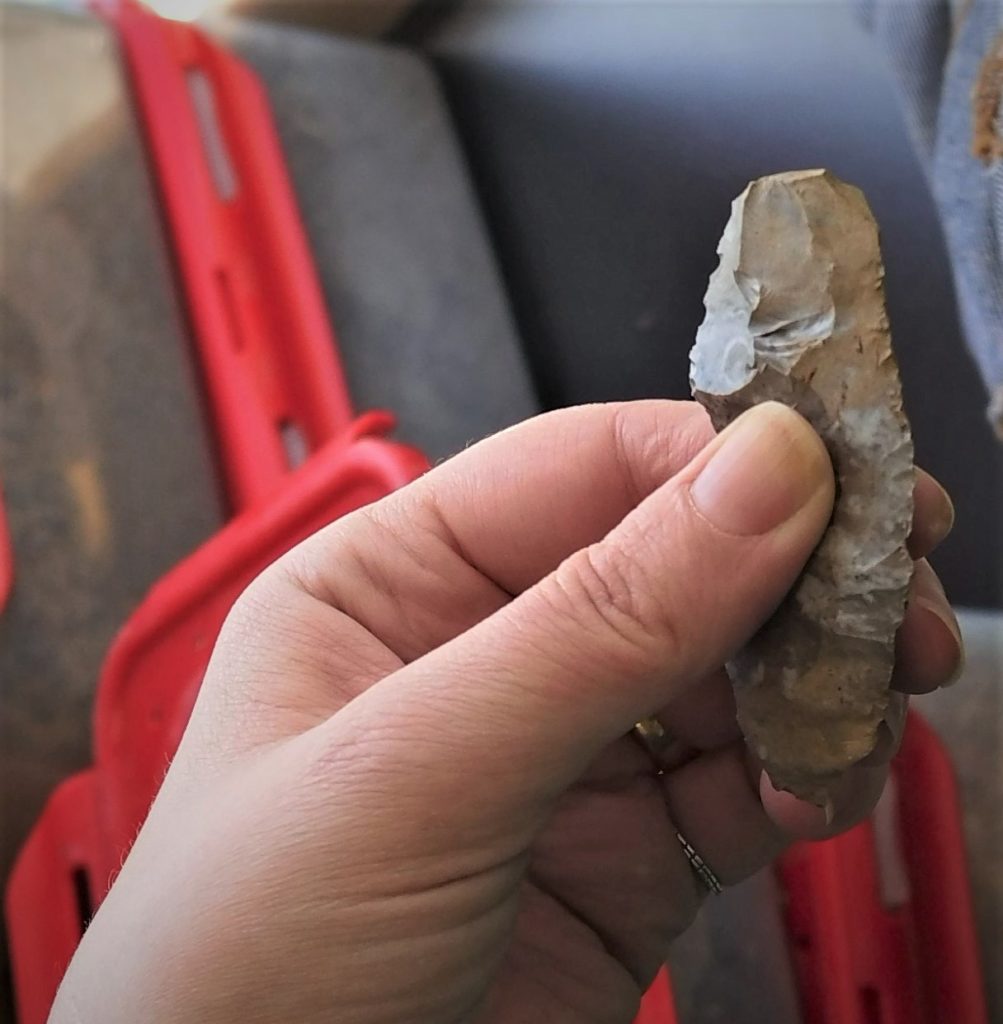Frozen Charlotte

The so-called ‘Frozen Charlotte’ was a popular Victorian era doll made of white bisque porcelain. Its classic version is small and nude, with limbs moulded to the body. The dolls were mass-produced and inexpensive, the smallest version cost a penny. A sought-after toy, they were manufactured by the millions from mid-19th century into the early […]
Left Handed Stone Knife

A Lithic Analyst’s Ode to a Stone Knife The loss of a favourite pocket knife was an alarming incident for many a young boy or girl growing up. Maybe it was the perfect whittling knife we carried with us as Scouts or Guides, or a “coming-of-age” gift from Grandpa. Nevertheless, in a few days we […]
Projectile Point with Embedded Fossil

This projectile point fragment was discovered during field walking and it contains the extra surprise of a tiny, fossilized bivalve shell embedded inside the grey and white chert. Because were are missing the base and tip of this point, we can’t identify the exact age or style of this tool. It was also found in the middle of a small […]
Early Archaic Nettling Point

We present to you a 3-D scan of a gorgeous Early Archaic Nettling point discovered this past winter by our Field Director Robb Bhardwaj, who shared his story of discovery with us: Nettling Projectile Point by ASI on Sketchfab “Sometimes in archaeology, artifacts seem to want to be found. I came upon just such an […]
Lice Combs

Whether rich or poor, rural or urban, all people in the nineteenth century struggled with lice. Just over a hundred years ago, dealing with lice was a commonplace, unremarkable irritant. In fact, the lice comb is one of the most common personal artifacts that we dig up from Ontario historical sites. We find lice combs […]
Movember: Moustache Teacup

In honour of Movember, we wanted to show you the moustache teacup we found at the mid-to-late nineteenth century Weir I site in Scarborough. This teacup is nearly complete, with a floral decalcomania motif. Moustache teacups were made with a semicircular ledge on the inside to protect one’s highly-styled and waxed moustache from steaming tea. A small opening in the ledge would allow the tea […]
The Humble Nail

The humble nail is one of the key tools that we use to date historical sites. Three major types of architectural nails are found on Ontario sites, as well as the horseshoe nail. Hand-wrought nails: Square, or nearly so (in cross section), usually tapered to the point; head may be “rose shaped” (domed); common to 1830. […]
The John Elford Bottles

Every artifact has a story to tell, as is the case with these three bottles excavated from the John Elford site near Courtice, Ontario. This bottle from the Northrop & Lyman Co. of Toronto held one of many purportedly medicinal concoctions the company marketed out of its Toronto warehouse beginning of 1874. The history of the […]
Mast Stepping: The Schooner Penny

Over the centuries, minted metal coins have been used to purchase everything from slaves to bread. The power such a small object possesses in society is incredible and often goes way beyond a simple transaction in a shop, market stall or even international banking. The recent discovery of an early 19th century American penny (circa […]
The Lower Canada Rebellion Penny

This featured artifact was a politically-charged little coin back in its day… Due to a chronic shortage of small coinage in the mid 1830s, banks were permitted to mint their own to fill the gap. This coin, found at the Botsford Site near Newmarket in 2003, is known as a “Bouquet Penny” or “Rebellion Penny” because […]









